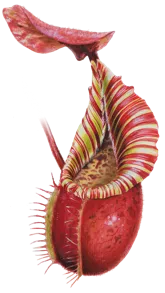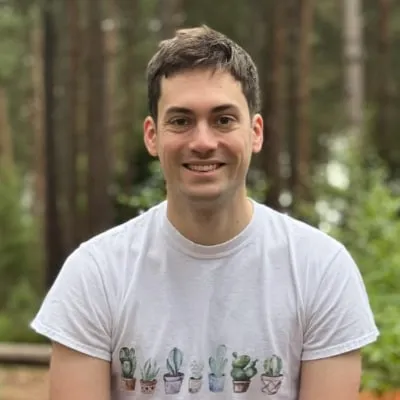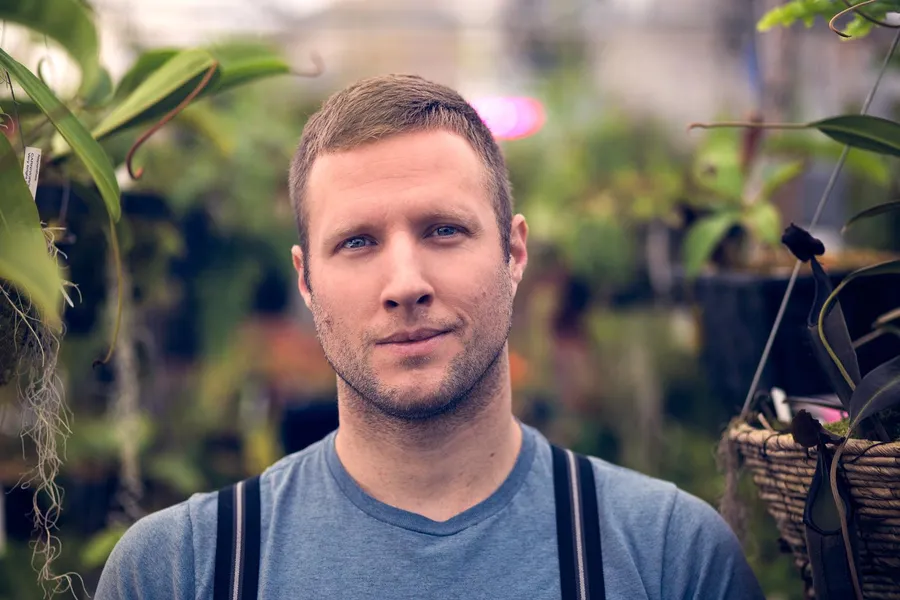Native Exotics (since renamed to Florae Collaborative) is a carnivorous plant nursery based in Trumansburg, New York. I recently got the chance to speak with founder Ryan Georgia and his business partner (and fellow grower) Michael Kevin Smith. As well as discussing the company’s startup origins and their future plans, Ryan and Michael shared their thoughts on the carnivorous plant community and offered some growing advice for fellow Nepenthes enthusiasts. The stunning photos of the Native Exotics nursery which appear throughout the article were taken by Francis Bauzon.
Enjoy, and be sure to subscribe for more stories like this!
Contents
1. The Native Exotics Nursery
How did Native Exotics get started?
RG: Native Exotics started out about 6 years ago. My then-partner was getting her Ph.D. in plant science and we decided to go to Borneo. I’d wanted to go since I was a little kid, just because it’s the mecca for both fauna and flora. We went backpacking to Kota Kinabalu and stayed for a couple of months, and I focused on Nepenthes. Through school I’d acquired a small seed collection permit - initially it was for some research, but it also ended up being the start of some of the plants we currently have in our lab.
I fondly remember getting back and about 3 weeks later, I had purchased a greenhouse! I hadn’t discussed it with my partner at the time, and she was not all that thrilled. In the very beginning, I really didn’t have a plan - I’d got the greenhouse with some intent of starting a business, but also as a place to keep my growing collection.
Click on any photo to zoom in. Use arrow keys or swipe to navigate.
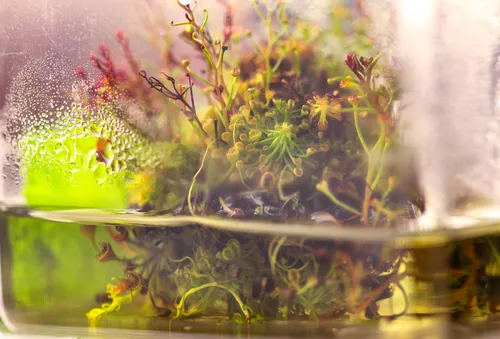 Drosera growing in-vitro in the Native Exotics tissue culture lab
Drosera growing in-vitro in the Native Exotics tissue culture lab 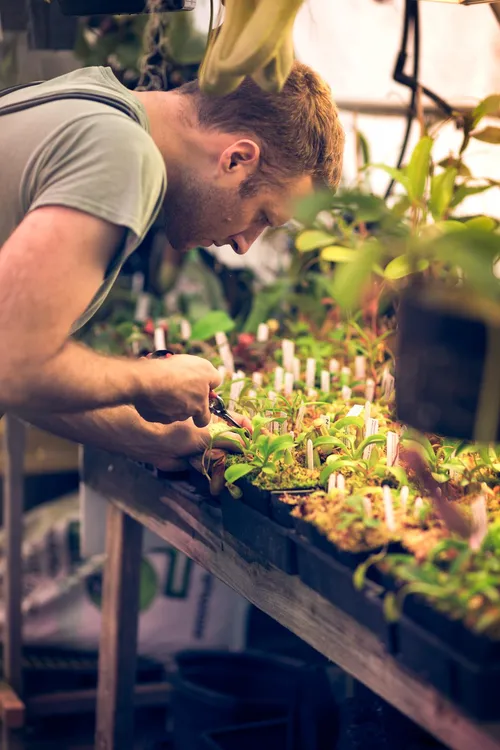 Ryan at work in the Native Exotics nursery
Ryan at work in the Native Exotics nursery And did you set up the Native Exotics lab right after you got back?
RG: It was pretty much right afterwards! At that time I was fortunate enough to have a house, and I retrofitted an entire room into a tissue culture laboratory. At the very beginning I actually built laminar flow hoods, and even sold a few, but that was way too much work.
A lot of the tissue culture (TC) techniques are proprietary, at least as far as Nepenthes goes. Compared to orchids, for example, the difference is there’s a multi-million or even multi-billion dollar market, so their research outpaces what’s done for Nepenthes. The companies that do deal with it have made it rather proprietary. So for us, it was trial and error for quite a while. Some of it is similar to other plants that have been mapped out in a lot of detail, but it seems to be species-specific in a lot of instances with Nepenthes. What works for one species often doesn’t work for another. It’s an interesting adventure.
Meeting the demand for certain characteristics is often challenging with seed-grown Nepenthes, given their polymorphism.
With TC it’s easy to damage tissues and cause aberrations, but in theory, done correctly, there’s no difference between a TC plant and a cutting. It’s all down to the genetics of the specimen; it’s perfectly possible for seed grown plants to do poorly as well.
As people are starting to get a better understanding of TC, and techniques improve, we’re seeing more of a demand for it. I think that’s partly driven by the desire for certain characteristics. Meeting that demand is often challenging with seed-grown Nepenthes, given their polymorphism - you can get such drastic differences from the parents in the offspring of a cross.
Tell me about your growing setup today - where’s your nursery based, and which genera do you currently focus on?
RG: We’re in upstate New York, just outside of Ithaca, on a 4-acre property. We have a 48 x 20 ft greenhouse, and this Spring we’re putting up another that’s 100 x 30 ft. We’re scaling up, and applying everything I learnt over the past 6 years to the new greenhouse.
The greenhouse holds both intermediate and highland Nepenthes, as well as Heliamphora, Cephalotus, Utricularia, and Pinguicula. We’re slowly moving towards getting into the Sarracenia market at some point down the road, plus Venus flytraps, and so on. We’ve got the land for that ready.
To heat the greenhouse, we started out using propane, but it became expensive and we didn’t like what that was doing to the environment. One of our major concerns is our carbon footprint, so we invested in a large 185,000 BTU wood pellet boiler, and we have another 250,000 BTU unit for the next greenhouse. The pellets are locally-produced, so it’s less expensive and in many ways more efficient.
We’re looking into the possibility of a storefront, particularly as we start to focus more on the native plants like Sarracenia.
The nearby building holds my office, our 14 x 8 ft lowland chamber, and our tissue culture lab. It’s a fully functional lab with laminar flow hood, autoclave, everything that we need. We produce our own water using reverse osmosis, and that’s supplied to the greenhouse as well as throughout the building.
We’ve been getting a lot of interest from growers all over the States who want to visit us, so we’re looking into the possibility of a storefront in downtown Ithaca, particularly as we start to focus more on the native plants like Sarracenia.
Click on any photo to zoom in. Use arrow keys or swipe to navigate.
 The Native Exotics greenhouse in snow
The Native Exotics greenhouse in snow 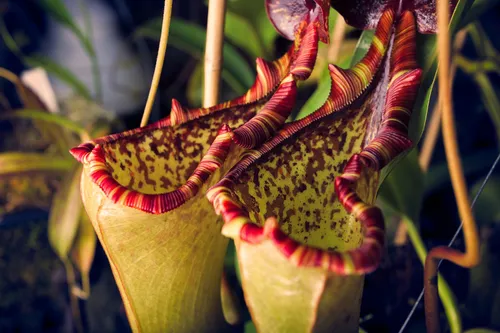 The warped peristome of Nepenthes lowii x Gothica, one of the nursery's breeding plants
The warped peristome of Nepenthes lowii x Gothica, one of the nursery's breeding plants How about your website? You guys are separated by thousands of miles, so how did Mike become your developer and partner?
MKS: That relationship started in mid-2014. Ryan was doing a really good job on social media, posting availability lists from Borneo Exotics and Malesiana Tropicals, but his website was very basic. I initially approached him as a customer with enquiries about certain plants, but at some point down the line I asked if he was interested in a more advanced site and an updated design.
Obviously Ryan being an entrepreneur, and Native Exotics being a start-up at the time, I tried to be respectful of the fact that he probably couldn’t pay for the services in the traditional way, so I said I’d just take payment in the form of plants!
Ryan’s introduced certain plants where we simply didn’t know what the price was gonna be, and our auction platform is a good way to see what the market dictates.
We then worked together to roll out a complete e-commerce platform with inventory, customer, and order management using open-source products. While Ryan’s scaling up the physical infrastructure of Native Exotics, I’m focused on the web technology infrastructure. We collaborate on all aspects of operations and continually try to improve the user experience for our customers. Recently we added the ability to hold auctions. Ryan’s introduced certain plants where we simply didn’t know what the price was gonna be - Nepenthes monticola, or new species from Papua New Guinea, for example - and our auction platform is a good way to see what the market dictates.
There’s also a big gap between what someone’s willing to pay in the UK versus the States. From what I’ve seen, species have always been in higher demand with European growers, whereas hybrids seem to be more popular here in the States. Everyone here wants Exotica Plants hybrids and that kind of stuff - that seems to be universal though, at this point!
Click on any photo to zoom in. Use arrow keys or swipe to navigate.
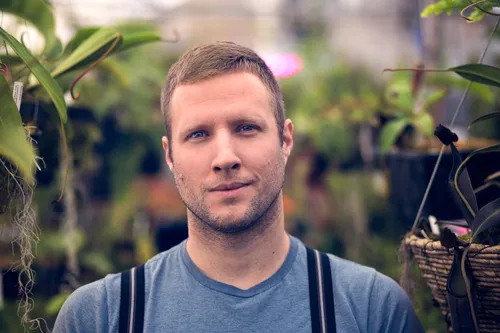 Founder Ryan Georgia
Founder Ryan Georgia 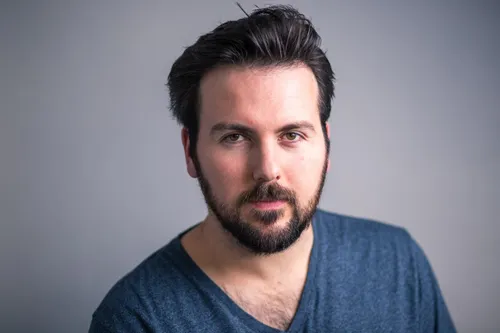 Ryan's business partner and web developer Michael Kevin Smith
Ryan's business partner and web developer Michael Kevin Smith The Exotica Plants catalog update seems to be worldwide phenomenon for Nepenthes growers!
MKS: Yeah, Ryan can definitely speak to that! Personally, I still have problems really getting into it. Ryan and I are fairly good at identifying plants, but at a certain point - for me, anyway - a lot of those complex hybrids start to look the same.
It’s always fascinated me how people are willing to buy stuff purely on the name. Some nurseries will post a list of plants with no photos - you’re buying based on a name, diameter, and maybe a location, so you’re basically taking a gamble. That’s why Ryan always makes a lot of effort to either show the exact plant your buying or something very similar, so there are no surprises for customers.
Click on any photo to zoom in. Use arrow keys or swipe to navigate.
![A complex hybrid, Nepenthes ventricosa-squat x [ventricosa x (lowii x ventricosa)]](/_astro/A%20complex%20hybrid_%20Nepenthes%20ventricosa-squat%20x%20_ventricosa%20x%20(lowii%20x%20ventricosa)_.Ba9ruacz_ryHDP.webp) A complex hybrid, Nepenthes ventricosa-squat x [ventricosa x (lowii x ventricosa)]
A complex hybrid, Nepenthes ventricosa-squat x [ventricosa x (lowii x ventricosa)] 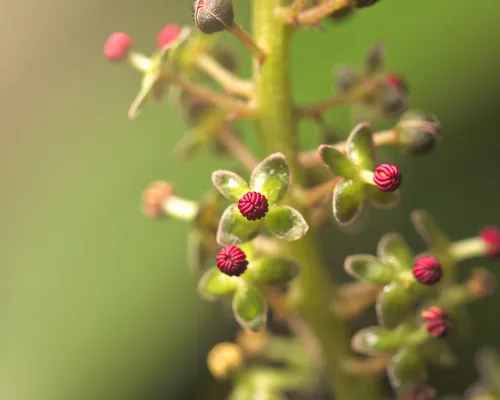 Nepenthes inflorescence
Nepenthes inflorescence Speaking of Exotica Plants, you have relationships with a lot of other nurseries and distributors around the world. How did that come about?
RG: It was purely to keep up with demand, and the ever-changing carnivorous plant climate! Customers would ask for a particular N. veitchii from Borneo Exotics, for example, or a seed-grown N. klossii or whatever. Based on this demand, we reached out to Rob Cantley at Borneo Exotics, Geoff Mansell at Exotica Plants, Andreas Wistuba, Christian Klein, and so on. A lot of these relationships were forged based on what the customers actually wanted.
I have actually met Rob Cantley and Diane, a couple of years ago at a trade show. It was a lot of fun to meet these people I’d looked up to since I was a teenager! They’re a great couple, great people. I also found out some cool things about Rob - he used to be a DJ, then some kind of police officer, then head of a large plant tissue culture wholesale corporation. He’s on an interesting journey!
But yeah, all the distributors are pretty easy to work with. I’ve had no qualms with any of them.
So how do you decide which plants to stock at any one time?
MKS: At the end of the day, Native Exotics is a business, so we have to look at which plants will have an actual return. Take N. hurrelliana for instance; when plants have substantial demand, they’re very expensive even close to the source. If someone germinates some seeds and sells the plants for $300, there’s obviously not a lot of room for markup. We need plants that are actually going to turn a profit and keep the lights on at the nursery!
The barrier to entry to starting a “carnivorous plant nursery” is very low. I could buy in wholesale quantity from another nursery and then start a company around that, selling plants with a markup, all with little investment.
By buying from established and reputable nurseries, you’re investing in the company and helping them have more buying power and access to rarer plants.
So a key challenge for us as a business is to distinguish ourselves as a stable source for these plants. We try to do that partly with our service: with Native Exotics you’re getting acclimated plants, which have typically been hardened in the greenhouse for about 6 months. People often overlook that, and split hairs on price.
We also think it’s important to promote and support other CP nurseries, like California Carnivores and Predatory Plants - we’re all contributing to making these plants widely available. By buying from these established and reputable nurseries, you’re investing in the company and helping them have more buying power and access to rarer plants, so ultimately the customers benefit.
Click on any photo to zoom in. Use arrow keys or swipe to navigate.
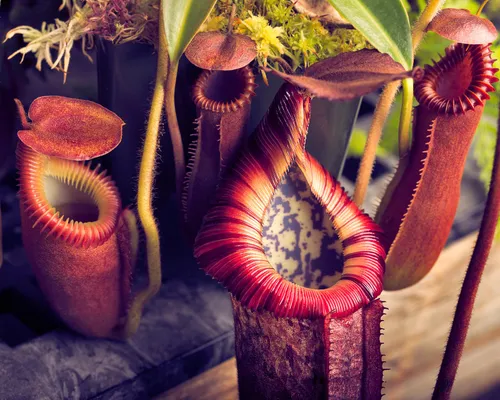 Nepenthes villosa, Nepenthes edwardsiana, and the clone sold as Nepenthes burbidgeae x edwardsiana which possibly has N. villosa introgression or is N. burbidgeae x villosa outright
Nepenthes villosa, Nepenthes edwardsiana, and the clone sold as Nepenthes burbidgeae x edwardsiana which possibly has N. villosa introgression or is N. burbidgeae x villosa outright 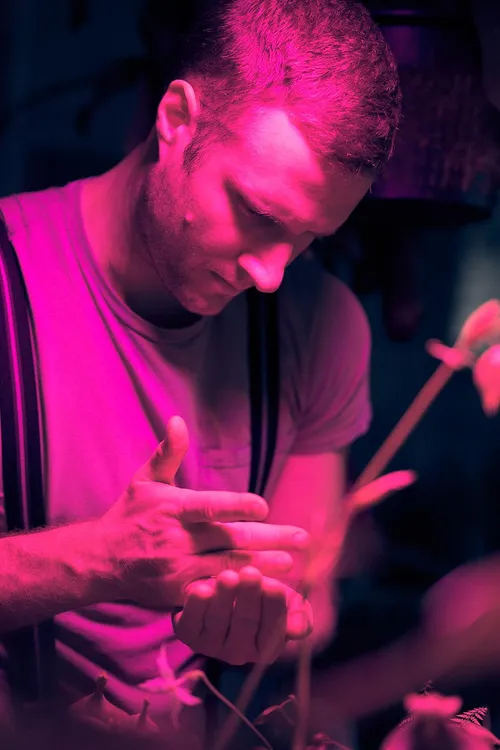 Ryan at work in the nursery
Ryan at work in the nursery 2. The Community & Conservation
You’ve mentioned that habitat conservation and the environment are big concerns of yours. Has this always been the case?
RG: It was important to me even before my trip to Borneo, but my awareness of conservation concerns became heightened through the carnivorous plant community. It’s a problem in every hobby community - it’s just as prevalent in orchids, for example.
Education needs to be a part of the recipe to address the poaching issue, because a lot of people don’t understand what a serious issue it is.
At the very beginning I had no idea that poaching was so rampant - I knew it existed, but I didn’t know to what degree. It seems to have increased almost exponentially over the past few years. Whilst I understand the implications, I also have an understanding of why some people are contributing to it, and it’s complex and really frustrating. Education needs to be a part of the recipe to address the poaching issue, because a lot of people don’t understand what a serious issue it is.
MKS: Education & conservation is one of the core pillars of Native Exotics. With all the auctions, we give a small percentage to Meadowview Biological Research Station in Virginia. They do a lot of native pitcher plant conservation for Sarracenia flava and Sarracenia purpurea in the D.C., Maryland, Virginia area. And that’s where I’m from, so I’ve also done a lot of volunteering there.
On a positive note, customers seem way more tuned into their plants, and to the sources of those plants as well. Plants that are potentially poached will get called out publicly.
RG: I’m grateful for that. I like the fact that it sets a platform for accountability. It speaks volume to the conservation of these plants, and the furthering of that cause.
Click on any photo to zoom in. Use arrow keys or swipe to navigate.
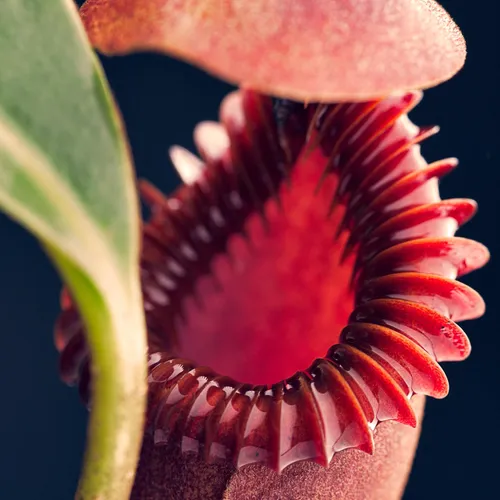 The beautiful Nepenthes edwardsiana
The beautiful Nepenthes edwardsiana 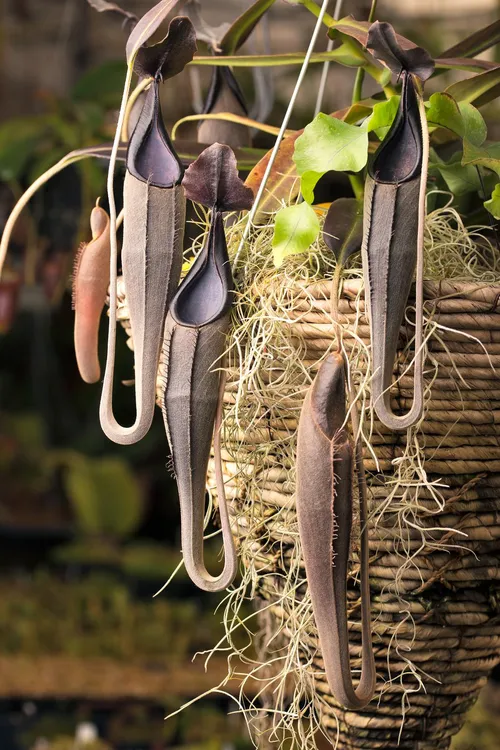 The distinctive shapes and colours of Nepenthes lingulata
The distinctive shapes and colours of Nepenthes lingulata A lot of the other nurseries I’ve spoken to have said that the whole hobbyist community around carnivorous plants seems to be growing. Have you observed this too?
RG: There seems to be a significant increase in growers in the community, just based on sales and communication with other growers. From my observation everything seems to point towards growth, including stress levels!
MKS: I tend to always view things through the Nepenthes lens, since that’s where my passion is. When I first started in the hobby, the Nepenthes for sale were mostly more common species and odd hybrids. Now we’re light years ahead of that. It would be interesting to calculate what percentage of the 170 species are now available - it would be pretty high.
You see plants that are barely available in cultivation being used in crosses, and it makes you wonder who’s growing these plants to flowering size!
New species are discovered and then made available a year or two later - it’s amazing. You see plants that are barely available in cultivation being used in crosses, and it makes you wonder who’s growing these plants to flowering size?! It’s a really exciting time to be in the hobby.
Social media is definitely responsible for some of this growth, and it’s made the concept of a web forum seem somewhat archaic. People used to do these big photo dumps, but forums are an overkill for that. Instagram provides a great platform where I can easily share photos and communicate with other growers: I can comment, ask about the parents of a cross, whatever.
There’s a plethora of growers sharing photos - Tom I enjoyed your article on the carnivorous plant growers of Instagram, it really captured a slice of that excitement. It’s the perfect platform for carnivorous plants, really. People just want to see eye candy and nice specimen plants!
3. Growing Spaces & Species Tips
What advice would you offer to growers - and prospective growers - based on the questions you receive from your customers?
MKS: I think everyone should try to assess their grow space before acquiring lots of plants. You can then try to match that space with a certain band of plants. People often group Nepenthes into 5 distinct groups: ultra-lowland, lowland, intermediate, highland, and ultra-highland. Tom, you have that Nepenthes species temperature and altitude chart - I’d suggest using a tool like that to identify a range you can accommodate year-round, then collect plants in that band.
I also think it’s smart to match the amount you’re spending on your plants with the amount you’re putting into your setup. If you’re buying a $200 N. macrophylla, N. trusmadiensis, or any kind of expensive plant, you better spend at least that much on your grow space too!
Everyone should try to assess their grow space before acquiring lots of plants… identify a range you can accommodate year-round, then collect plants in that band.
We see a lot of people using the chest freezer method which Jeff Shafer came up with. It’s a brilliant way to grow highland and ultra-highland plants, but it can be extremely risky. You need to have a failsafe, and you need to spend the right amount to get the right controls in place.
RG: With today’s technology, a lot of people are experimenting with more complex systems, but in many cases people would be better off if they just followed Jeff’s original guide. It’s very simple, robust, and more failsafe than some of these current modifications people are doing.
MKS: I’ve gone down very dark paths before. I’ve used poorly modified air-conditioners to grow ultra-highland plants, I’ve flooded my parents’ basement, I’ve destroyed rental properties with nice hardwood floors where my grow chamber was leaking.
Long story short, grow what will be the path of least resistance, rather than whatever’s in vogue. If you can sustain a particular temperature consistently, you’ll enjoy your plants a lot more than if you’re constantly stressing about the weather forecast and having to move your plants around. You might get more enjoyment growing robust hybrids with N. veitchii or N. chaniana in them, as opposed to something that doesn’t pitcher at all, leaving you wondering whether it’s a humidity problem, whether it’s fungus, whatever.
Click on any photo to zoom in. Use arrow keys or swipe to navigate.
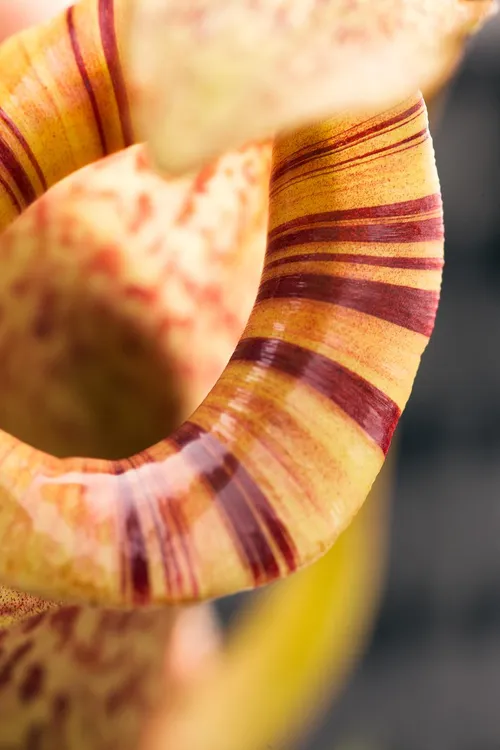 Nepenthes platychila peristome
Nepenthes platychila peristome 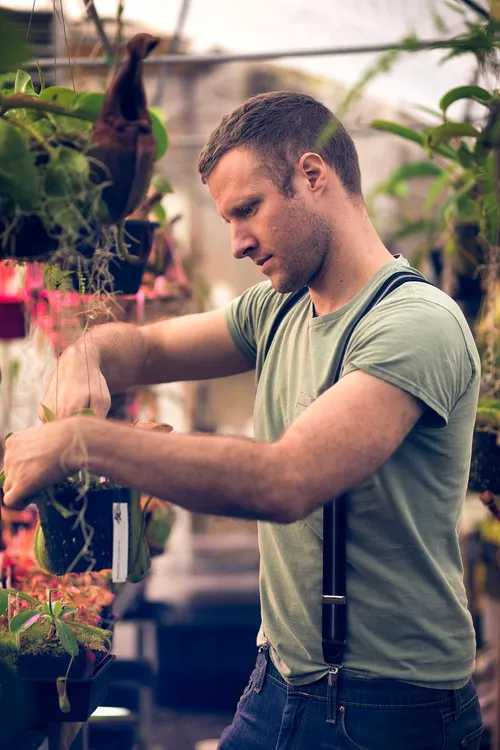 Ryan propagating young Nepenthes plants in the nursery
Ryan propagating young Nepenthes plants in the nursery Are those the species you would recommend to new growers?
RG: In my experience anything that’s hirsute makes for an easy plant to grow. N. veitchii, N. maxima, N. chaniana; any of those make for great windowsill plants that don’t necessarily need as much humidity.
Any hybrids with those hirsute plants are often very tolerant, too. They’re not expensive and they can be stunning. Hybrids with N. truncata and N. robcantleyi are also quite easy and can be grown as windowsill plants.
In my experience, anything that’s hirsute makes for an easy plant to grow. N veitchii, N maxima, N chaniana; any of those make for great windowsill plants.
I have a beautiful N. veitchii x chaniana growing on my kitchen windowsill, and it’s amazing how well it’s adapted. In the winter it’s exposed to temperatures of upper 30s and low 40s (4° - 6°C), and it’s still doing fine. It’s sort of dwarfed by the semi-harsh conditions, but it’s been there for a couple of years and produces 2 or 3 pitchers at a time. It’s very colourful, about a foot-and-a-half tall. It’s a Borneo Exotics clone. That’s a great plant!
MKS: Another point for new growers is to remember that seedlings usually don’t exhibit all the characteristics of an adult plant. People often see a photo of a perfect adult specimen, and they look for those qualities in smaller seedlings, not realising that many of those qualities only become apparent later.
The other big piece of advice is to take everything you hear with a big pinch of salt. As a grower gets more years under their belt, they get more set in their ways, but there are too many variables for a one-size-fits-all approach. For example, I auto-mist my outdoor Nepenthes continuously all day here in San Diego. If an indoor grower saw my setup and went and installed a misting system, they could kill their plants, because there may be no airflow inside their chamber to prevent rot. There are many different elements to consider, including light, humidity, soil, temperature, pH, water quality, and many more.
Click on any photo to zoom in. Use arrow keys or swipe to navigate.
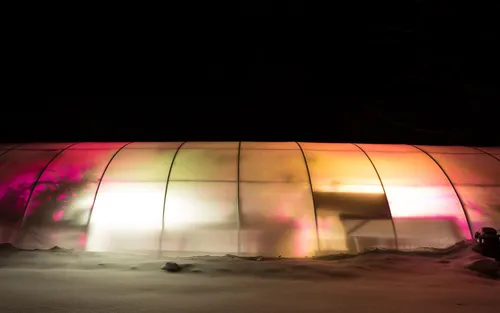 The Native Exotics greenhouse during snowy weather
The Native Exotics greenhouse during snowy weather 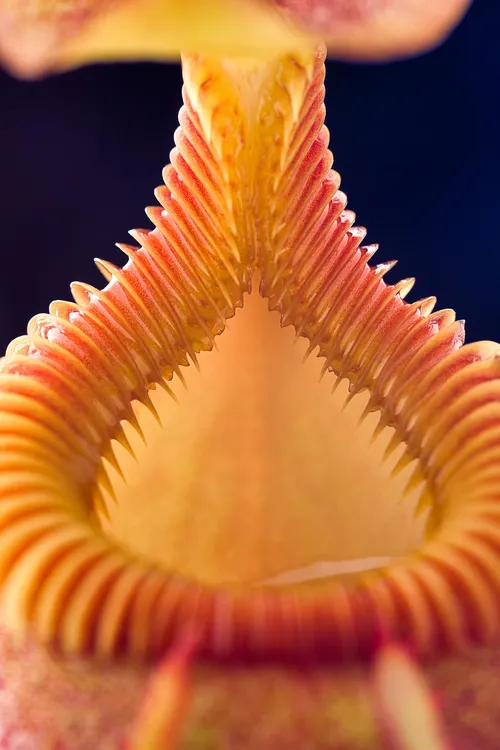 The toothy peristome of Nepenthes villosa
The toothy peristome of Nepenthes villosa What’s your favourite species right now?
RG: I feel like I’m not original here, but Nepenthes villosa has always been my favourite. It’s also one of the first plants I saw growing in the wild.
MKS: He has an amazing specimen of N. villosa, probably one of the best in the States. Native Exotics has an N. villosa clone too, one of our first, and a strong performing clone too.
Favourite species is always a tough question to answer, but mine is N. undulatifolia. It’s the encapsulation of all the best features of the Sulawesi species. It’s got all this cool stuff from N. pitopangii, N. hamata, N. tentaculata, and N. eymae, many of which still aren’t widely available. There are always weird rumours from people who travel to Sulawesi, too - like I heard there’s a brown hairy hamata, an eymae wavy leaf, oh my god. I can’t even imagine. So much folklore! It’s such a mysterious place, and the plants totally embody that.
Many thanks to Ryan and Mike for taking the time to speak with me and share their story. Make sure to visit the Native Exotics website, and follow Ryan, Mike, and photographer Francis on Instagram.
If you run a carnivorous plant nursery, society, or are involved in conservation efforts to protect these magnificent plants and would like to share your story on Tom’s Carnivores, please get in touch.
